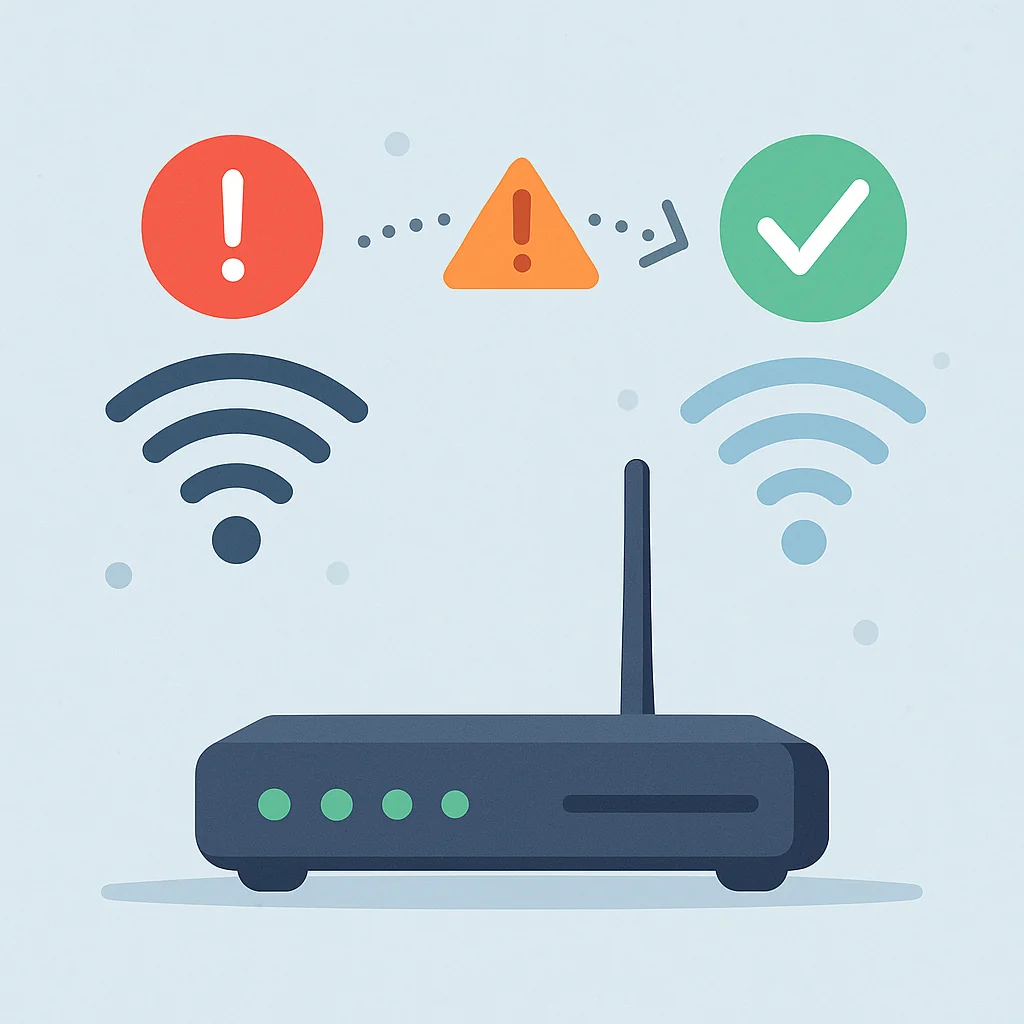Your cart is currently empty!
Category: Networking

Advanced ADSL Stability Script: Real-Time CRC Monitoring and Auto-Recovery
For TP-LINK ADSL modems.
If you’re stuck with an ADSL connection, you’ve probably experienced random disconnections, unstable speeds, or the dreaded CRC error spikes that cripple your internet. The worst part? These issues often happen while the connection is technically “up,” but completely unusable.
Instead of manually restarting the modem every time the connection gets unstable, I decided to automate the entire process using a lightweight Bash + Expect script. Now, my modem resets itself when things start to go wrong — and my internet remains stable without me lifting a finger.
What Exactly Did I Build?
- A script that monitors CRC errors in real time by connecting to the modem over Telnet.
- When the number of CRC errors exceeds a configurable threshold (e.g., 100 errors), the script automatically sends a reset command to the modem.
- All actions are logged with timestamps for easy review.
- The script runs continuously and checks the connection every few seconds.
Why Is This Important?
- CRC errors on ADSL lines often don’t increase gradually.
- Instead, the error count can explode into the thousands within minutes, leading to massive packet loss and unusable internet — while your modem still shows as “connected.”
- ISPs usually lock your line speed and don’t dynamically adjust it when signal quality degrades.
- Manual resets become a constant annoyance… unless you automate them.
How Does It Work?
The script uses
expectto reliably automate Telnet sessions with the modem. It:- Logs into the modem using Telnet.
- Retrieves the current CRC error count.
- If the error count crosses the defined limit, sends the
wan adsl resetcommand. - Logs every reset with a timestamp.
The Script
#!/bin/bash MODEM_IP="192.168.1.1" PASSWORD="admin" CRC_LIMIT=100 CHECK_INTERVAL=5 check_crc() { expect -c " set timeout 10 spawn telnet $MODEM_IP expect \"Password:\" { send \"$PASSWORD\r\" } expect \">\" { send \"wan adsl perfdata\r\" } expect \">\" { send \"exit\r\" } expect eof " | grep -i "CRC" | head -n 1 | grep -oE '[0-9]+' } reset_adsl() { expect -c " set timeout 10 spawn telnet $MODEM_IP expect \"Password:\" { send \"$PASSWORD\r\" } expect \">\" { send \"wan adsl reset\r\" } expect \">\" { send \"exit\r\" } expect eof " > /dev/null 2>&1 echo "$(date): ADSL connection reset due to CRC errors!" >> /var/log/adsl_watchdog.log } echo "Started ADSL Watchdog ..." while true; do crc_count=$(check_crc) crc_count=${crc_count:-0} echo "$(date): Trenutni broj CRC grešaka: $crc_count" if [ "$crc_count" -gt "$CRC_LIMIT" ]; then echo "$(date): CRC Threshold reached ($CRC_LIMIT). Resetting connection..." reset_adsl sleep 60 else sleep $CHECK_INTERVAL fi doneI recommend running this on Raspberry pi 🙂

Wie fügt man eine zusätzliche IP-Adresse bei Netcup auf einem Debian-Server hinzu?
Wenn du bei Netcup eine zusätzliche IPv4-Adresse (meist als /32 routed IP) zu deinem Server hinzugefügt hast, musst du diese manuell auf dem Server konfigurieren. In diesem Artikel zeige ich dir, wie du das korrekt unter Debian 12 einrichtest.
Schritt 1: IP im Netcup Panel routen
- Melde dich im Netcup Kundenpanel an.
- Gehe zu deinem vServer oder Root-Server.
- Klicke auf „IP-Adressen“.
- Wähle die zusätzliche IP aus (z. B.
81.16.19.220). - Klicke auf „IP auf Server routen“.
Ohne diesen Schritt wird die IP nicht an deinen Server weitergeleitet!
Schritt 2: IP-Adresse unter Debian hinzufügen
Falls du DHCP verwendest (Standard bei vielen Netcup-Images), kannst du die zusätzliche IP mit einem systemd-Service dauerhaft hinzufügen.
Erstelle das Skript:
sudo nano /etc/network/additional-ip.shFüge folgenden Inhalt ein:
#!/bin/bash
ip addr add 81.16.19.220/32 dev ens3
ip route add 81.16.19.220/32 dev ens3Speichern und ausführbar machen:
sudo chmod +x /etc/network/additional-ip.shErstelle den systemd-Service:
sudo nano /etc/systemd/system/additional-ip.serviceInhalt:
[Unit]
Description=Zusätzliche IP-Adresse hinzufügen
After=network.target
[Service]
Type=oneshot
ExecStart=/etc/network/additional-ip.sh
RemainAfterExit=yes
[Install]
WantedBy=multi-user.targetDann aktivieren:
sudo systemctl daemon-reload
sudo systemctl enable --now additional-ip.serviceTesten
Nach dem Reboot oder sofort nach Aktivierung kannst du mit
ip aprüfen, ob die IP aktiv ist:ip addr show ens3Und von extern mit:
ping 81.16.19.220📌 Hinweis: Diese IP kann z. B. in NGINX oder Mailservern gezielt verwendet werden, indem man sie im Service bindet.

Solving Cross-Subnet VM Communication in Hetzner
Note: All IP addresses in this article have been modified to protect client privacy
When managing virtual machines across different subnets in a node with Virtualizor environment, you might encounter networking challenges that aren’t immediately obvious. I recently tackled such an issue in a Hetzner where VMs with IPs from different subnets couldn’t communicate with each other.
The Problem
Here was my setup:
- A node Virtualizor with a main IP address
- Three different subnets allocated:
- 192.168.1.0/29 (connected to natbr8)
- 10.10.20.0/29 (connected to natbr7)
- 172.16.5.0/29 (connected to natbr5)
- VMs with IPs from different subnets (specifically 10.10.20.6 and 192.168.1.4) couldn’t talk to each other
While some might suggest that Hetzner blocks cross-subnet communication by default, the reality is more nuanced. Hetzner doesn’t inherently block such communication – the issue is that proper routing configuration is needed to enable it.
The Solution
After troubleshooting, I found that solving this problem required configuring several networking components:
1. Host-level NAT and Forwarding Rules
First, I needed proper NAT masquerading for traffic between subnets:
# NAT rules for cross-subnet communication iptables -t nat -A POSTROUTING -s 192.168.1.0/29 -d 10.10.20.0/29 -j MASQUERADE iptables -t nat -A POSTROUTING -s 10.10.20.0/29 -d 192.168.1.0/29 -j MASQUERADEThen I needed to ensure packet forwarding between network bridges:
# Allow forwarding between bridges iptables -A FORWARD -i natbr7 -o natbr8 -j ACCEPT iptables -A FORWARD -i natbr8 -o natbr7 -j ACCEPTiptables -A FORWARD -o natbr7 -m state --state RELATED,ESTABLISHED -j ACCEPT iptables -A FORWARD -o natbr8 -m state --state RELATED,ESTABLISHED -j ACCEPT2. IP Routing Rules
Special routing rules were needed to correctly handle traffic between the specific VMs:
# Add routing rules for specific VMs ip rule add from 10.10.20.6 to 192.168.1.4 ip rule add from 192.168.1.4 to 10.10.20.63. VM-level Configuration
Inside the VM with IP 192.168.1.4, I added a specific route:
ip route add 10.10.20.6 via 192.168.1.1 dev eth0The VM with IP 10.10.20.6 already had appropriate routing via its default gateway:
192.168.1.0/29 via 10.10.20.1 dev eth0How It Works
With this configuration, here’s how traffic flows:
- When VM 192.168.1.4 sends a packet to VM 10.10.20.6:
- The packet gets routed through gateway 192.168.1.1
- The host applies NAT masquerading
- The packet is forwarded from natbr8 to natbr7
- The packet arrives at VM 10.10.20.6
- When VM 10.10.20.6 sends a packet to VM 192.168.1.4:
- The packet gets routed through gateway 10.10.20.1
- The host applies NAT masquerading
- The packet is forwarded from natbr7 to natbr8
- The packet arrives at VM 192.168.1.4
Lessons Learned
This experience taught me several important things about cloud networking:
- Provider policies aren’t always the culprit – While some cloud providers do restrict cross-subnet communication, often the issue is just proper configuration.
- Layer by layer troubleshooting is essential – Working through each networking layer (VM routes, host forwarding, NAT, etc.) methodically led to the solution.
- VM-level routing matters – Even with correct host configuration, each VM needs to know how to route packets to other subnets.
- Documentation is crucial – After fixing the issue, documenting the solution thoroughly saved time when I needed to replicate or modify the setup later.
For anyone facing similar issues in Hetzner or other cloud environments, I recommend examining your routing tables, NAT rules, and forwarding configurations at both the host and VM levels. The problem is almost always solvable with the right networking configuration.
Do you face similar networking challenges in your infrastructure?
